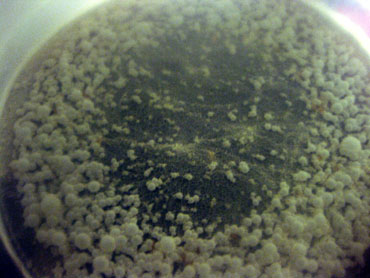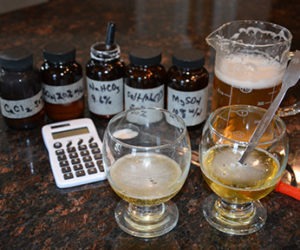Overnight Acidification

While sour beers aren’t the “next IPA,” at a minimum it’s the next Bourbon-barrel imperial stout. As a humble man, I can only give my book American Sour Beers (Brewers Publications, 2014) 80-85% of the credit for this recent spike in popularity! Now it seems that aging time and cross-contamination concerns are the prime reasons many homebrewers buy rather than brew sours. From brew-day-to-glass a traditional mixed-fermentation spans an excruciating 4 to 24 months. This time is required for three waves of microbes to complete the fermentation: First, brewer’s yeast ferment the simpler carbohydrates leaving the lactic acid bacteria (LAB) and then Brettanomyces to slowly ferment dextrins and starches. While there is no way to fully replicate the subtle flavors of a classic mixed-fermentation in only a few weeks, there is a shortcut to produce a sour beer in just a couple days more time than a standard ale!
While sour mashing was long the go-to method for quick Berliner weisse or Gose, souring the wort instead holds several advantages. Sour mashing relies on Lactobacillus living on malt to dominate the other wild microbes. Under less-than-perfect conditions these bacteria produce butyric and isovaleric acids, imparting flavors of old cheese, feet, vomit, or worse! Even the wort from a well-executed sour mash can release spouse-infuriating aromatics into your brewery during the boil. Separating the wort from the spent grain after souring can also be challenging. There is nothing authentic about sour mashing German styles anyway; I’m unaware of any history of sour-mashed Berliner weisse in its homeland!
Lactobacillus and Pediococcus are the two LAB used to sour beer. For quick souring, Lactobacillus is the clear winner. It reproduces and ferments quickly, and thrives in unhopped wort. Pediococcus is often a better option after primary fermentation because it is more acid- and hop-tolerant, and able to ferment carbohydrates all the way up to starch. However, it produces two unpleasant byproducts (i.e., diacetyl and exopolysaccharides) that Brettanomyces and time are required to clean up.
Lactobacillus on its own will not make a particularly interesting beer compared to a long-aged sour. Think of it as the difference between yogurt (quickly soured with Lactobacillus) and bleu cheese (requires a slow mixed fermentation). Most people mix other flavors into their yogurt because it’s so neutral. A stinky bleu needs no accompaniment, although it may benefit from a pairing.
Wort Composition
Five IBUs can inhibit some strains of Lactobacillus, so sour the wort before hopping. You can add a couple IBUs, but this is well below the flavor threshold and will not benefit the final beer. In terms of fermentables, anything goes! Kettle souring is actually a better choice than a mixed-fermentation if you want sweet and tart (e.g., oud bruin), or strong and sour (e.g., historic porter). There is no reason to favor alpha amylase for saccharification or add maltodextrin as you might for a more traditional sour because kettle souring puts LAB first in line at the buffet.
I prefer to kettle sour exceedingly flavorful beers. Berliner weisse benefits from slower mixed-fermentation because it has so little malt/hop character, but a sour beer loaded with apricot puree or Citra® dry hops gains little from subtle fermentation complexity!
Boil the wort as usual to kill any wild microbes and provide a clean slate. Chill to 100-110 °F (38-43 °C) and add enough refined lactic acid to lower the pH of the wort to 4.5 (approximately 10-20 g of 88% lactic acid). Pre-acidification provides two crucial benefits. First, it inhibits reproduction by enteric bacteria, which create off-flavors and cause allergic reactions for some drinkers. Second, the lower pH reduces the activity of Lactobacillus’s proteolytic enzyme, which is especially active at 113-122 °F (45-50 °C), thus preserving head retention and body. As the pH scale is logarithmic, lowering the pH from 5.5 to 4.5 requires about 10% of the acid of the full trip from 5.5 to 3.5 (“about” because wort has buffering capacity allowing it to resist pH changes).
Lactobacillus Source
While you can rely on Lactobacillus residing on malt added directly to the partially-cooled wort, this will produce inconsistent results similar to sour mashing. According to Andreas Richter of Weyermann, their acidulated malt is “devitalized” during kilning and so holds no advantage as a source for Lactobacillus. Rather than adding the grain itself, grow a small starter by adding 1⁄2 cup (119 mL) of crushed pale malt to 1 pint (474 mL) unhopped starter wort adjusted to a pH of 4.5: Use a heating pad or water bath to hold the temperature between 110-115 °F (43-46 °C) to favor the Lactobacillus. Making a starter gives you an opportunity to preview the flavors and a sense of how much acidity to expect.
Supermarkets sell a surprising array of Lactobacillus sources including probiotics and cultured dairy (e.g., yogurt and buttermilk with “live active cultures”). Look for known aggressive acid producers such as L. brevis and L. plantarum. You may need to try several brands to find one that works for your temperature, target acidity, and time constraints. I’ve read especially positive results from GoodBelly StraightShot and Nancy’s Greek Yogurt.
Lactobacillus does reproduce more rapidly than Saccharomyces cerevisiae, but for kettle souring avoid sources that contain both bacteria and yeast, such as bottle dregs and sourdough bread starters. The yeast will produce unpleasant flavors when fermented warm.
I prefer commercial brewing cultures for ease and consistency. Luckily there are excellent isolates available, see my article with Matt Humbard “Brewing with Lactobacillus: Overview and Evaluation” (May-June 2015 BYO) for more information on selecting a strain. Omega Labs OYL-605 (Lactobacillus Blend) and White Labs WLP672 (Lactobacillus brevis) were the two top performers!
You don’t have to make a large starter or target a particular pitching rate for Lactobacillus. However, as the goal is rapid activity, make a 1 cup (237 mL) starter 24 hours in advance to ensure viability.
Fermentation Vessel
If you are pitching a less controlled source of Lactobacillus (e.g., grain-based), sour the wort in a vessel that will not let air in. Most Lactobacillus are heterofermentative, and thus will produce small amounts of ethanol and CO2, so allow pressure to escape (i.e., affix an airlock or pressure release). The best option is a dedicated fermenter or keg that can be purged with carbon dioxide. If you are pitching a pure culture, the presence of some oxygen is not a major concern because Lactobacillus is aerotolerant, so a mash tun or stainless steel boil kettle can work. Do not worry about “infecting” your hot-side equipment.
Lactic Acid Fermentation
Lactobacillus works quickest at 110-115 °F (43-46 °C), but most strains ferment well at warm room temperature. Do not aerate the wort, and if you are using a grain-based culture, flush the vessel with CO2 before filling.
Lance Shaner of Omega Yeast Labs performed a fascinating experiment showing that pure Lactobacillus cultures will not ferment much in excess of 10% apparent attenuation (http://www.milkthefunk.com/wiki/100%25_Lactobacillus_Fermentation). This suggests that those of us who have witnessed full attenuation (70%+ AA) from Lactobacillus either unknowingly introduced yeast or did not start with pure cultures.
Measuring Acidity
To determine if the wort is sour enough you can rely on your senses. However, as worty-sweetness will still be present, it is difficult to accurately gauge acidity. Use taste in conjunction with an analytic method such as pH meter or titratable acidity. For lightly tart you want a pH in the mid-high 3s, for firm acidity low 3s. For titratable acidity a similar range would be 0.25-0.75% lactic acid (multiply by 1.2 to convert to lactic acid if your kit is testing for tartaric acid).
Once the target acidity is achieved (12-96 hours) you can either chill the wort, aerate, and proceed with fermentation or pasteurize to halt the souring process. Once the wort is brought up to 170 °F (77 °C) for a few seconds, it can be treated as you would clean wort with no risk of cross-contamination. This is a big reason kettle souring has become so popular, there is no risk from sharing one set of cold-side equipment. You could boil the soured wort if you wanted to add hot-side hops or other flavorings, but stick to pasteurization if you saw significant attenuation indicating the production of alcohol.
Alcoholic Fermentation
Whether or not you pasteurize, you need to pitch yeast to finish the fermentation. Soured wort is a tough environment for brewer’s yeast because many strains do not thrive at a pH below 3.5. Anecdotally, some of the best strains for completing a quick sour that I am familiar with are Wyeast 3711 (French Saison), Safale US-05 (American Ale), and Wyeast 1007 (German Ale). Always make a starter for liquid cultures, and rehydrate dried cultures. Aerating the wort and adding yeast nutrient before pitching will also increase the probability of a healthy fermentation.
If you want some of the complex fruity-funkiness of a traditional sour, deploy a 100% Brettanomyces fermentation! Brett is acid-tolerant, and will create the fruity ester ethyl lactate by combining lactic acid and ethanol. However, a high concentration of lactic acid can also reduce Brettanomyces’ production of some of the more interesting esters such as pineapple-y ethyl caproate.1
Get Your Sour On
If you’ve been looking for an excuse to brew your first sour beer, wanting a tart fruit-bomb in the emerging “Florida Weisse” style, or trying to find a way to make a 14% ABV sour stout, kettle souring might be the answer! There is no requirement for dedicated equipment, stable aging temperature, and no barnyard flavor descriptors (I’m into it, but not everyone is)!


